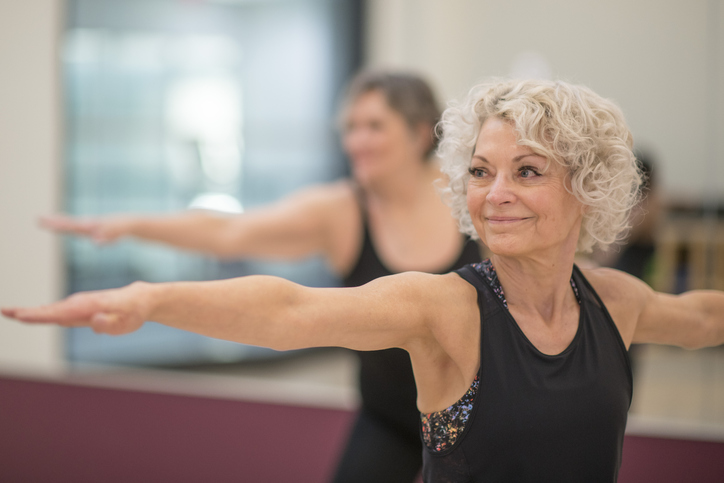
Benefits of Balance Exercises for Older Adults
Good balance is important for helping adults retain mobility as they age. Exercises that improve balance can help enhance mobility and prevent falls. Falls are more common among older adults and can result in hip fractures, broken bones and even head injuries.
In this article, we’ll examine some of the benefits of maintaining and improving balance and share some simple yet effective exercises to help you do just that.
Benefits of Improving Balance for Older Adults
As we age, most of us lose some coordination, flexibility and balance. This happens primarily due to inactivity and can make it easier to fall. Outside of fall prevention, there are a number of other ways older adults can benefit from improving their balance. Here are some examples.- It can help you stay independent. Being mobile, strong and steady on your feet means that you can keep pursuing the activities and hobbies you enjoy
- It can boost your self confidence. Moving with relative ease can give you the confidence to participate in more activities and social events in a comfortable way
- It can improve your well-being. Those with better balance are more likely to experience an improvement in well-being because they are able to stay active
- It can help you avoid injuries. Not only can balance exercises help prevent falls, but they can also build muscle, which lowers the odds of injury if you do take a tumble
3 Easy Balance Exercises for Older Adults
The American Heart Association recommends that older adults at risk of falls should do balance training three or more days a week. While you should always consult a doctor before starting a new exercise routine, here are three examples of balance exercises to get you started on the road to greater mobility.Assess Your Fall Risk Factors
As you put together your balance exercise strategy, it may be helpful to understand your current abilities and target areas you can improve. At Abbey Delray, we offer all residents access to VSTBalance and VirtuSense, an automated fall-risk assessment tool that utilizes artificial intelligence with machine vision to objectively identify fall risk indicators by evaluating balance, gait and function. The evaluation only takes a few minutes, and creates a report that assists residents in identifying early deficits in balance, gait and function that can be addressed by skilled treatment. Treatment plans can then be created using engaging biofeedback activities that assist in reducing falls and improving mobility. This type of risk assessment and the creation of unique, personalized plans has been shown to:- Reduce post-acute care falls by 73%
- Improved mobility for residents by 85%
Sit-to-Stand Balance Exercise
According to Johns Hopkins Medicine, the sit-to-stand exercise “builds leg strength and improves body mechanics and balance, which are all important in reducing falls.” You’ll need a chair.- Start by sitting on a sturdy chair of standard height. Make sure it won’t slide or roll. You should be able to sit comfortably with your feet flat on the ground. You should also have a sturdy support surface in front of you so that you can reach out for support as needed.
- Scoot forward to position your buttocks at the front of the seat.
- Lean your chest forward over your toes, shifting your body weight forward. Squeeze your gluteal muscles and slowly rise to a stable standing position.
- Slowly sit back down to the starting position and repeat 10 times.
Stand on One Foot Balance Exercise
Researchers say the ability to stand on one foot for at least 10 seconds can be an indicator of your overall health. The goal of this balance exercise, also from Johns Hopkins, is to help improve your balance so that you can work toward standing on one foot for 10 seconds or more. For this exercise, you’ll want to either have someone with you, stand in a corner or have a sturdy surface in front of you for support. Supervised exercise is always the safest option.- Stand with your feet about shoulder-width apart. Keep your eyes open and hold steady for 10 seconds, working your way up to 30 seconds. Once you can hold this position firmly for 30 seconds with minimal swaying or support, move on to the next step.
- Stand with your feet together, eyes open, and hold steady for 10 seconds. Work your way up to 30 seconds. Once again, practice this position until it becomes comfortable.
- Stand on one foot, eyes open, and hold steady for 10 seconds, working up to 30 seconds. Switch to the other foot and repeat. Hold steady for 10 seconds, working up to 30 seconds. Move back and forth between standing on opposite legs for five repetitions per foot.
Heel-to-Toe Walk Balance Exercise
According to Healthline, this heel-to-toe walk balance exercise “strengthens your legs and improves balance.” Once again, we recommend supervision with any new exercise.- Stand with your heels pressing into a wall.
- Place your left foot in front of your right foot.
- Touch your left heel to your right toes.
- Place your right foot in front of your left foot.
- Touch your right heel to your left toes.
- Continue for 20 steps.

